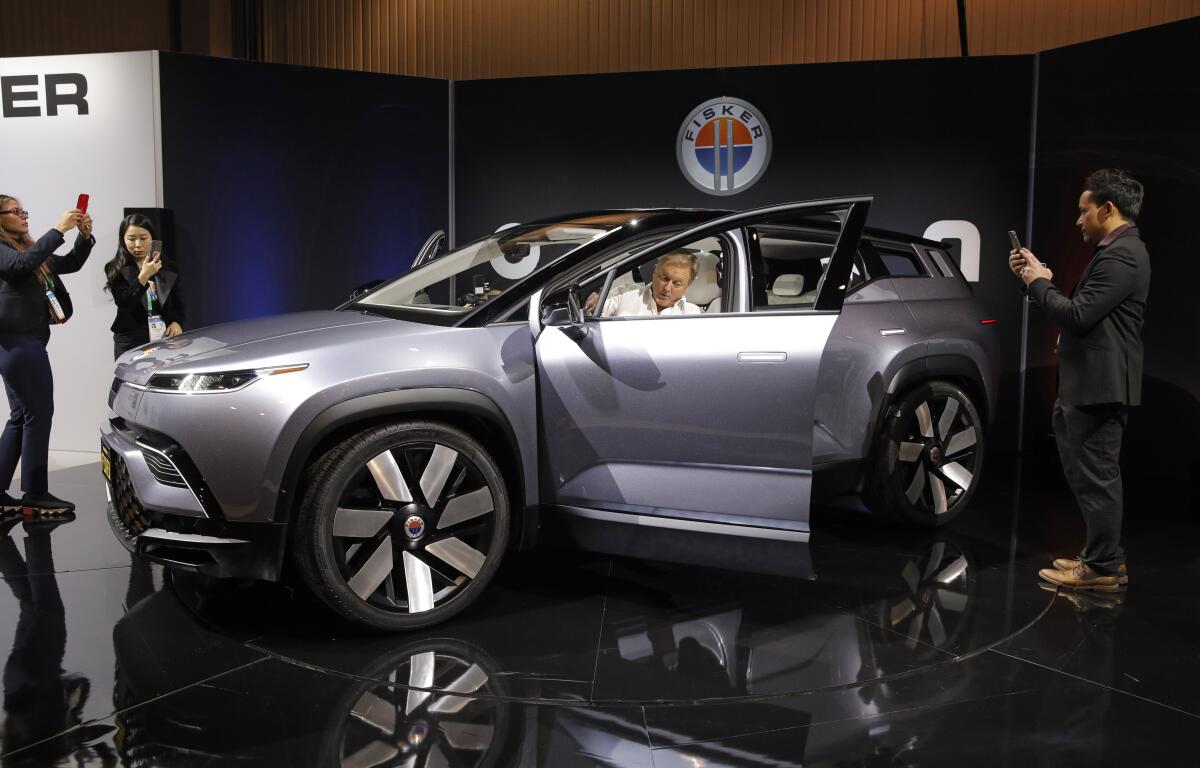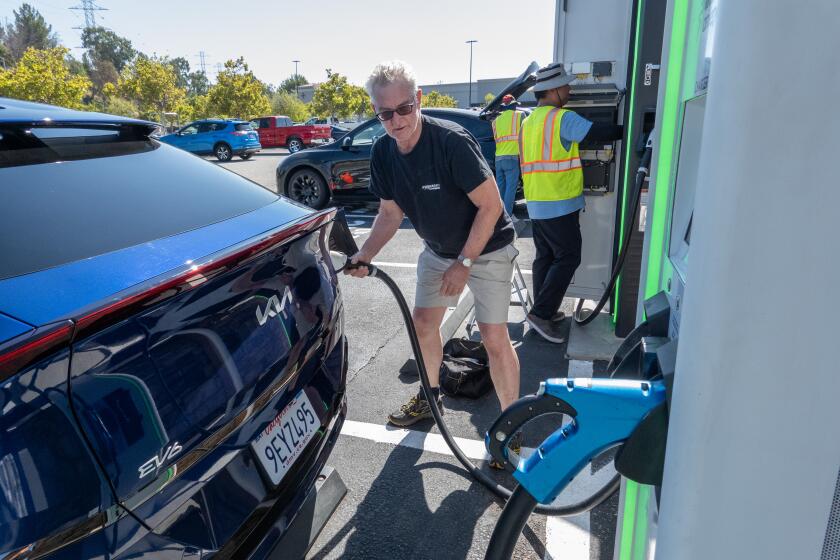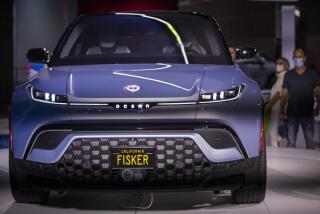Fisker had big dreams to compete with Tesla. What went wrong with this Manhattan Beach company?

- Share via
A decade ago, respected automobile designer Henrik Fisker was coming off the bankruptcy of his first car company when he contemplated his comeback. Instead of a luxury hybrid sedan, what he envisioned was an all-electric SUV that would appeal to the masses with its lower price and California beach-inspired design.
The Danish native put the car on the road last year, when his new Manhattan Beach company, Fisker Inc., released the Ocean. The midsize crossover features a full-length solar roof, an interior composed of “vegan” recycled plastic and a drop-down rear window that can fit a surf board. Starting price of the base model: $38,999.
The vehicle gathered design awards and the company initially projected it would make as many as 42,400 vehicles in its first year. Instead, Fisker produced just 10,193 vehicles at its contract manufacturing plant and delivered 4,929 vehicles — racking up sales of $273 million, but losing $762 million in 2023.
More signs of distress emerged in recent weeks as Fisker announced it was cutting 15% of its 1,200-person workforce, halting production for six weeks and working on a deal for $150 million in new financing, dependent on forging a strategic relationship with a major auto manufacturer.
Henrik Fisker is raising $2.9 billion to build and market the Fisker Ocean all-electric compact SUV
On Monday, the company said talks for a strategic tie-up had not proved fruitful and the New York Stock Exchange moved to delist its stock, which collapsed and closed Wednesday at 2 cents per share. Fisker reiterated a warning it made earlier: that it might be forced to file for bankruptcy protection.
What went wrong? Multiple factors contributed to the company’s fall, analysts said, including the challenges of starting an auto company from scratch, fierce competition in the EV market and production difficulties with its flagship Ocean SUV.
“When you are trying to start a car company, it is really, really hard,” said Karl Brauer, executive analyst at iSeeCars.com, an automotive research website. “It’s a capital-intensive business and you have to go up against all these established players to successfully produce a car at a volume rate and at a price that makes you money.”
A spokesperson for the company declined to comment and said Fisker was not available.
Fisker isn’t the only EV startup that has been struggling in a crowded field. Industry sales have slowed amid higher interest rates that have made the costly cars more expensive and increased the challenges of expanding the market beyond the affluent first adopters who made Elon Musk’s Tesla one of the most highly valued companies in the world.
Lucid Motors, a Newark, Calif.-based maker of luxury SUVs and sedans, got a $1-billion cash infusion this week from its biggest backer, an affiliate of Saudi Arabia’s Public Investment Fund. Last month, Apple announced it was ending development of a self-driving electric vehicle after reportedly spending more than $10 billion on the project over a decade.
A crowded market
Fisker, 60, drew attention designing cars such as BMW’s Z8 and Aston Martin’s DB9 before launching his first company, Fisker Automotive, in 2007. The Anaheim startup produced the Fisker Karma, an undulating $100,000-plus plug-in hybrid coveted by Leonardo DiCaprio and other Hollywood celebrities. Fewer than 3,000 were made before the company went under when its battery supplier went bankrupt, among other setbacks.
He had bigger dreams for a new company that would sell electric vehicles to car buyers across the globe. It went public in 2020 via a SPAC, or special purpose acquisition company, backed by big Wall Street private equity firm Apollo Global Management. The company raised $1 billion in capital and was valued at $2.9 billion, a figure that soared as investors poured in, capitalizing on the sky-high expectations for EV sales.
This time around, Fisker suffered some self-inflicted wounds, analysts said. That included releasing a vehicle — the Ocean — that was not quite ready for market, while trying to reduce its capital costs and raise profit margins by outsourcing all manufacturing. In contrast, Tesla and other California startups such as Lucid and Rivian in Irvine, maker of the popular R1T pickup truck, operate their own domestic plants.
California has ambitious climate goals, including a pledge to ban the sale of new gasoline- and diesel-powered cars and light trucks by 2035.
“We’re like Apple-Foxconn,” Fisker said days prior to the company’s October 2020 debut on the New York Stock Exchange, referring to the Taiwanese maker of Apple’s iPhone. “This is the target we’re setting for ourselves, to be the most profitable car company in the world.”
Fisker had contract manufacturing experience with the Karma, which was made by a Finnish company. This time, he reached an agreement to have the Ocean produced at a plant in Graz, Austria, operated by Magna Steyr, a subsidiary of Magna International, a large Canadian manufacturer of automobile components.
Magna is highly respected in the automotive world, and the plant has produced vehicles for U.S. and foreign automakers. Magna co-developed the Ocean’s platform, including the chassis and underlying technologies, but ran into manufacturing challenges last year. Fisker had to cut its production estimates several times, and when the cars were released last year they had software bugs.
In one YouTube video released last month, popular reviewer Marques Brownlee praised an early version of the car for its styling, ride and innovative features but then slammed it for problems with its drive modes, Bluetooth connectivity and other issues. The review — titled “This Is the Worst Car I’ve Ever Reviewed” — got 4.8 million views.
Software bugs
Fisker has said integrating the software for each component manufactured by the company’s subcontractors has been one of the Ocean’s biggest challenges. Last month, Fisker said the company would send its first over-the-air software update for the Ocean — a technology Tesla pioneered — and continue updates throughout the year and lifetime of the vehicles, using “driver feedback to fix software bugs and improve features.”
Jessica Caldwell, an industry analyst for Edmunds.com, said the auto review site has not yet published its own take on the updated vehicle, but reviews of early buggy versions of the SUV done by others haven’t helped its cause. “Giving people vehicles that are not quite done and ready — I feel like that is just setting yourself up for failure,” she said.
An updated Ocean reviewed by U.S. News and World Report this week got generally favorable grades, with the writer saying it had “more innovative tech, a far better design and build quality that I think is miles ahead” of the rival Tesla Model Y SUV — while still complaining about software bugs needing another update.
Magna’s plant in Graz has a storied history, producing vehicles such as the Mercedes-Benz E-Class, the Jeep Grand Cherokee and the new Toyota Supra — making the arrangement look like “it should work on paper,” said Needham & Co. analyst Chris Pierce. “But, you know, things are just a lot harder in the real world.”
A spokesperson for Magna declined to comment on Fisker but said the plant has produced 33 models and more than 4 million vehicles to “world-leading standards,” including the Jaguar I-Pace all-electric SUV.
Fisker, meanwhile, is pivoting away from selling cars directly and is moving to open a network of dealerships. Like other EV startups, Fisker copied the direct sales model adopted by Tesla that dispensed with the franchises that most automakers use to market, sell and service their vehicles. However, that didn’t work out.
Fisker said during last month’s earnings call that the company received 250 “expressions of interest” from dealers in North America and Europe, and expects to have a network of 50 by the second half of the year. It also will continue to sell directly in Europe. “I expect we will keep signing up multiple dealers every week during the next few months,” he said.
The company, which employs 1,200 people globally, including about 300 in Manhattan Beach, said the focus of the layoffs was in sales and related functions that would be handled by the dealer network.
Tesla could do without dealers, Bauer said, as Musk was a master at generating free publicity — and because the company had few competitors when it was founded by two entrepreneurs in 2003 and later taken over by the billionaire.
“Musk had enough money and a 20-year runway to make it happen,” said Bauer, who noted that amount of breathing room is no longer possible in an industry with multiple startups and legacy manufacturers producing their own electric vehicles.
He called Fisker’s plan to switch to a dealer network “too little too late.”
The company has released prototypes for two other vehicles: a sporty crossover SUV called the PEAR and the Alaska pickup.
Fisker announced in May 2022 that it planned to have the PEAR manufactured in a former General Motors plant in Lordstown, Ohio, acquired by iPhone maker Foxconn — but that has yet to come to fruition.
Nissan also was reportedly considering investing $400 million in Fisker and building the Alaska pickup at one of its U.S. plants.
In its regulatory filing Monday, Fisker said it was evaluating various options, including a possible restructuring, refinancing its debt, issuing new stock and selling assets.
On Wednesday, Fisker announced steep price cuts of more than 30% on its entire lineup of 2023 cars.
Industry observers have expressed doubt that another major automaker would want to rescue the company given its problems, but Pierce, the Needham analyst, hopes otherwise.
“I live in Northern California,” he said. “Pretty much everyone drives an EV. If you believe in the environment, you have kids and you want all these changes, it would be great if there was much more EV adoption. So if there is a $30,000 EV out there that drives adoption, I do hope there is a partner out there and they make it work.”
More to Read
Sign up for This Evening's Big Stories
Catch up on the day with the 7 biggest L.A. Times stories in your inbox every weekday evening.
You may occasionally receive promotional content from the Los Angeles Times.












